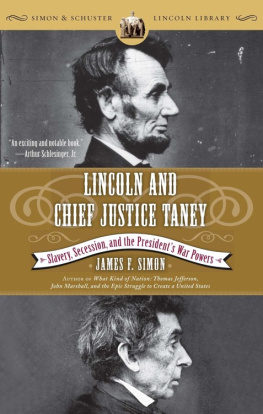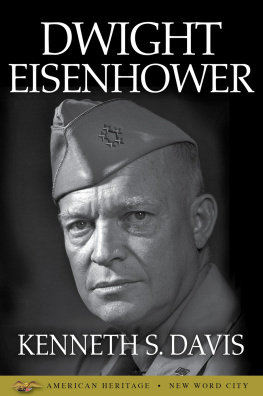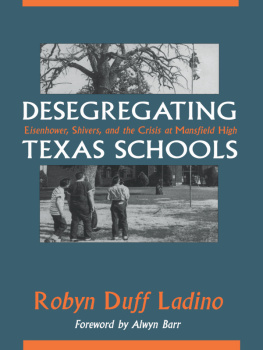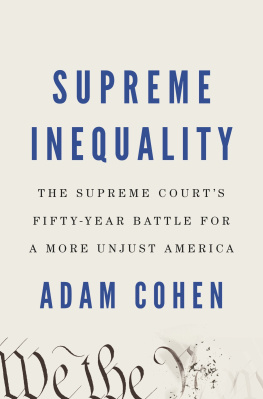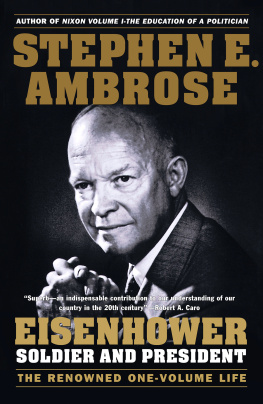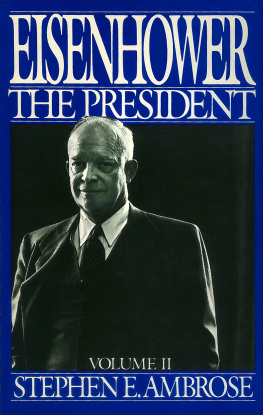
 | EISENHOWER
VS. WARREN The Battle for Civil Rights
and Liberties JAMES F. SIMON 
|  |
THE CALM, CONFIDENT FACE OF CALIFORNIAS GOVERNOR Earl Warren beamed from the cover of Time magazine on January 31, 1944. Time considered this Man of the West the front-runner for the Republican Partys vice-presidential nomination, presumably on the ticket with New York governor Thomas E. Dewey in their partys challenge to President Franklin D. Roosevelt in November. Life magazine went further, suggesting in a flattering story on Warren and his large, photogenic family that the California governor might even head his partys presidential ticket. Warren, fifty-two years old, had become a star on the national political stage barely a year after he had been elected to his first gubernatorial term.
The appeal of a Dewey-Warren ticket was obvious. Both men led large states from opposite coasts with a treasure trove of electoral college votes. Both had earned reputations as fearless prosecutors who had sent scores of corrupt officials, bootleggers, con men, and murderers to prison. Both were dedicated family men without a scintilla of scandal in their private lives. And they represented the moderate middle of their party, not as liberal as the partys 1940 standard bearer, Wendell Willkie, but more progressive than the leader of the conservative wing of the party, Ohio senator Robert A. Taft.
Warren offered a contrast in style and personality to Dewey. Whereas Dewey tirelessly promoted his image as an intrepid racket buster, Warren was more low-key, though he, too, cultivated reporters. Dewey was combative, while Warren seemed to radiate goodness and warmth, impressing visitors with his relaxed good nature and his evident simplicity.
Nothing in Warrens speeches during his twenty-five years in public office could explain the adulation. He was neither scintillating in style nor original in policy. But his patient, indefatigable work ethic produced impressive results. In a mere seventy-one days of the state legislative session, Governor Warren had pushed through bills that reduced the state sales tax, increased old-age pensions, established a postwar reconstruction and reemployment commission, and earmarked $43 million of state funds for postwar development.

EARL WARRENS FATHER, Methias Matt Warren, was an infant when his family emigrated to the United States in 1866 from southern Norway. Like many Scandinavian families in the mid-nineteenth century, the Warrens (anglicized from Varran) sought the open spaces of the upper Midwest that most resembled their native land. Matts father, a small farmer in Norway, attempted to resume his occupation in rural Illinois and later in Eagle Grove, Iowa. The family grewfive boys and three girlsbut the meager farm income could not support them. Matt and his older brother, Ole, therefore, were parceled out to neighboring farmers, earning their room and board by doing chores. After Matt completed the seventh grade, he and Ole moved to Chicago where Ole died of tuberculosis in his brothers arms. Penniless and alone, Matt vowed that he would never be broke again.
Earl Warren was born on March 19, 1891, on what was then called Dingy Turner Street, in a poor neighborhood of Los Angeles. Methias had moved to Southern California from the Midwest a year earlier and begun working for the Southern Pacific as a repairman and car inspector. On his modest income he struggled to support his wife, Chrystal, a Swedish immigrant, their daughter, Ethel, four years old, and their infant son. Soon after Earls birth, Methias went out on strike with other railroad workers in sympathy for the nationwide Pullman strike and, as a result, was blacklisted by the railroads Los Angeles office. He moved his family to the dusty, desolate town of Sumner, California, outside of Bakersfield in the Joaquin Valley, where he again found employment with the Southern Pacific. Although the railroad was Methiass employer for thirty years, he told his son that the corporation did not respect its workers or treat them fairly. Earl, like his father, witnessed the railroads indifference to workers debilitating injuries and the instant dismissals of unneeded workers without warning or severance. The experience ingrained in both father and son an enduring suspicion of large corporations.
Earl, saving is a habit like drinking, smoking, or spending, Methias Warren told his only son when he was growing up in the small town of Sumner. Always save some part of what you earn. Thrift was one of the important lessons that Earl Warren learned from his father, who was the greatest influence in his life. Methias also valued education, insisting that Earl graduate from high school in Bakersfield, when the children of most railroad workers had dropped out. Despite Methiass modest income, he saved enough to pay for his sons college and law school education at the Berkeley campus of the University of California.
The Warren family lived in a small row house across the street from the railroad yard in Sumner, a town of a few hundred people, a scattering of stores, saloons, gambling dens, and small hotels. The hotel patrons were usually itinerant railroad workers, known as boomers, or French and Basque sheep herders who came to town to market their livestock in the winter. This rugged frontier town seemed especially ill-suited for the intense, teetotaling Methias Warren. Unlike the rootless boomers, he was a devoted family man who adhered to a strict moral code and believed in perpetual self-improvement. He took correspondence courses in accounting and mechanics and taught Earl to read and write before he was five years old.
When Earl was in elementary school, he earned money delivering baked goods in a covered wagon in the early morning hours and carrying blocks of ice to homes in the summer heat that soared above 100 degrees. Working for the railroad as a teenager, his favorite job was as a caller, responsible for finding and rousing boomers to make sure they boarded departing trains for their next job. He searched for them in saloons and gambling dens, and, if unsuccessful, in their rooming houses and hotels. He proudly recalled that he never failed to find his man.
He also had fun, especially riding his burro, Jack, chasing jackrabbits, and trapping squirrels. His most exciting adventure occurred in April 1903, after he heard the news of a shootout between a notorious bandit named Jim McKinney and the Bakersfield marshal and his deputy, both of whom had been killed.his future career as a prosecutor. The defendant was found guilty and later slit his own throat in the local jail.
When the mesmerizing orator Russell Conwell delivered his inspirational Acres of Diamonds sermon in Bakersfield, young Warren listened intently and, decades later, recalled the details of the address. Greatness, said Conwell, was found in small deedsproviding better streets and sidewalks, schools and colleges, more happiness and more civilization. Highly moralistic in tone yet practical in advice, Conwells lessons shaped Warren, who would later set his own moralistic, practical agenda as district attorney of Alameda County, attorney general and governor of California, and Chief Justice of the United States.
Next page

